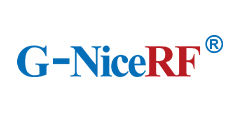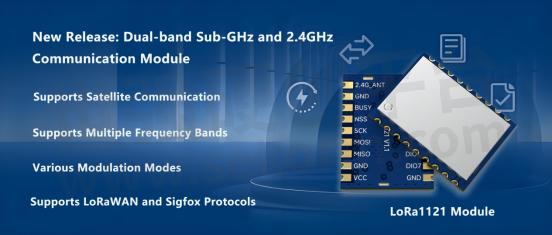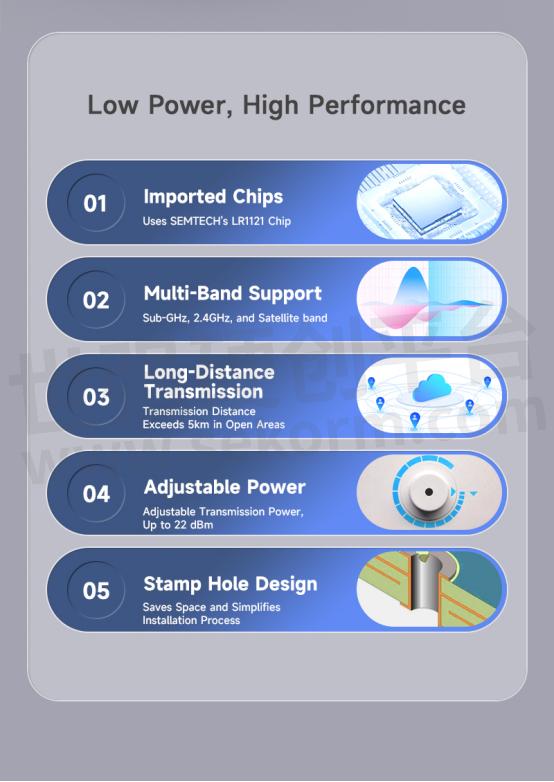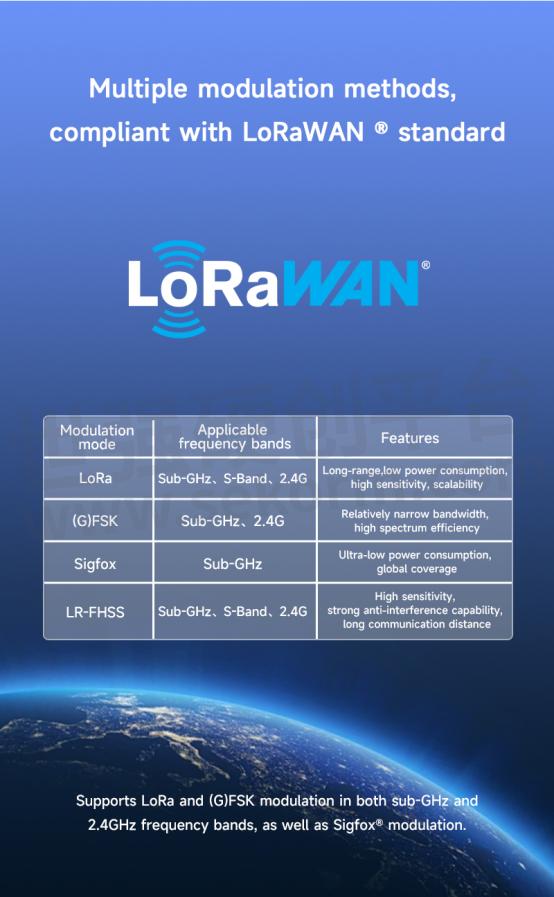G-NiceRF LoRa1121 Module Newly Released: Enables Multi-Band Compatibility and Satellite Communication Functionality

The LoRa1121 module utilizes SEMTECH's LR1121 chip, an ultra-low-power, long-range transceiver that supports both the global ISM band and 2.4GHz communication. The LoRa1121 supports LoRa and (G)FSK modulation in the sub-GHz and 2.4GHz bands, as well as Sigfox® modulation in the sub-GHz band, and long-range frequency hopping spread spectrum (LR-FHSS) in the sub-GHz, 1.9-2.1GHz, and 2.4GHz ISM bands. The LR1121 complies with the physical layer requirements of the LoRaWAN® specifications released by the LoRa Alliance® while remaining highly configurable to meet the needs of various applications and proprietary protocols.

Utilizes the SEMTECH LR1121 Chip, Compatible with Multiple Devices
LoRa1121 Dual-band Sub-GHz and 2.4GHz Communication Module use the SEMTECH LR1121 chip, which is fully compatible with the SX1261, SX1262, and SX1268 devices and complies with the LoRaWAN standard specification defined by the LoRa Alliance. It also features lower power consumption and broader frequency band support, offering greater flexibility and a wider range of applications.
Wide Frequency Band Coverage
UHF Band: Supports 433/470/868/915MHz
2.4GHz Band: Covers 2400–2500MHz
S Band: Covers 1900MHz–2200MHz
Sub-GHz (150-960MHz)
This frequency band covers the range from 150MHz to 960MHz and falls under the low-frequency category (i.e., Sub-GHz). The Sub-GHz band offers longer transmission distances and stronger penetration capabilities, making it particularly suitable for use in environments that require wide area coverage or have many obstacles.

S-Band (1.9GHz-2.2GHz)
The S-Band frequency range (1.9GHz-2.2GHz) lies between the UHF and microwave bands, offering good transmission distance and penetration capabilities. It also supports satellite communication, as this band includes the frequency range required for satellite communication (1900MHz-2200MHz), ensuring efficient and stable signal transmission in remote and extreme environments.
2.4GHz
The 2.4GHz band is a globally recognized ISM band that can provide high data transfer rates, making it suitable for short-range, high-data-rate wireless communication applications.
Multiple Modulation Methods, Cross-Band Compatibility Advantage
LoRa Modulation Applicable Bands: Sub-GHz, S-Band, 2.4GHz
LoRa modulation supports efficient data transmission within the Sub-GHz, S-Band, and 2.4GHz bands. The LoRa modulation technology offers long communication distances and good penetration capabilities, with its strong anti-interference ability and low power consumption making it exceptionally well-suited for long-distance, low-data-rate communication.
GFSK Modulation Applicable Bands: Sub-GHz, 2.4GHz
The GFSK modulation mode is a classic modulation method widely used in wireless communication. It provides reliable data transmission within the Sub-GHz and 2.4GHz bands, making it suitable for medium to short-distance communication applications.
Sigfox Applicable Bands: Sub-GHz
Sigfox is a wireless communication protocol specifically designed for low power consumption, operating in the Sub-GHz band. It is particularly well-suited for applications requiring low data transmission rates and long-distance communication. The global coverage of the Sigfox network and its low power characteristics give it a significant advantage in large-scale deployments.

LR-FHSS (Long Range Frequency Hopping Spread Spectrum) Applicable Bands: Sub-GHz, S-Band, 2.4GHz
LR-FHSS technology significantly enhances the anti-interference capability and transmission range of communication systems by hopping between multiple frequencies. Especially within the Sub-GHz, S-Band, and 2.4GHz bands, LR-FHSS can greatly improve the stability and range of data transmission.
It should be noted that in the LR1121, the implementation of LR-FHSS only supports the transmission function.
The frequency synthesizer of the LoRa1121 is shared between the Sub-GHz and high-frequency bands, allowing transmission bands to be switched through software. This design simplifies the hardware structure, enhances integration and cost-effectiveness, while providing flexible frequency band switching capabilities to meet various communication needs.
Excellent Reception Sensitivity, Long-Distance Transmission
S band sensitivity: up to -132 dBm@ BW=125 KHz, SF=12
2.4GHz reception sensitivity: up to-129dBm @ BW=406KHz, SF=7
Sub-GHz reception sensitivity: up to -144dBm @ BW=62.5KHz, SF=12
Transmission distance :>5000 meters at sub-GHz in the open area
Compatible with Multiple Communication Standards
The LoRa1121 module supports both LoRaWAN and Sigfox protocols, combining the advantages of long-range and low power consumption. LoRaWAN offers extensive network coverage and high security, while Sigfox is ideal for globally covered, ultra-low-power devices. This enables the LoRa1121 module to flexibly adapt to various communication needs.
The LR1121 supports storing the NwkKey and AppKey as defined in the LoRaWAN standard, providing a secure and reliable encryption method to protect network communication and application data.
Security
The hardware supports AES-128 encryption and decryption algorithms, ensuring the security of data transmission.
High Sensitivity and Low Power Consumption
The LoRa1121 module features extremely low power consumption, with a sleep current of less than 1µA and a receive current of less than 7mA, ensuring efficient power management during long-term operation. It also integrates electrostatic protection devices, enhancing the durability and reliability of the equipment.
In low-power mode, the LoRa1121 module can wake up the microcontroller at set intervals, allowing the module to activate the microcontroller for data collection or communication tasks within a specified time, maintaining low power consumption while ensuring timely data processing and transmission.
NiceRF's newly released LoRa1121 module, with its powerful features and hardware support, meets the demands of modern wireless communication systems for efficient, reliable, and flexible solutions. It consistently delivers stable and outstanding performance in applications such as remote monitoring, smart cities, and IoT devices.
The LoRa1121 consistently delivers stable and outstanding performance. Notably, the module's S-Band satellite communication functionality stands out in the market, becoming a key highlight of this product. Its unique core advantages offer users new possibilities.
- +1 Like
- Add to Favorites
Recommend
- G-NiceRF LoRa Backscatter Device LoRa1276-C1 Provides Long-Range Communication with Low-Power
- G-NiceRF’s New LoRa Spread Spectrum Modulation SOC Wireless Module LoRa-STM32WLE5 with Built-in ARM and Industrial Grade Crystal Oscillator
- G-NiceRF‘s FCC Certified Products for Wireless Transceiver Module: LoRa1276-915, RF2401PRO, RF2401F20, RF4463PRO
- What Features Should a Portable Walkie-Talkie Module Have? Take G-NiceRF SA828 for An Example
- What is the RSSI Function of LoRa Module
- The Gas Meter Reading Application of RF Module RF4463Pro from G-NiceRF Saves Much Person Resource
- Advantages of G-NiceRF ASK Transmitter STX883Pro and ASK Receiver SRX883Pro in the Market
- LR-FHSS Long-Range Frequency Hopping Spread Spectrum SUB-GHz and 2.4GHz 2-in-1 Communication Module Released
This document is provided by Sekorm Platform for VIP exclusive service. The copyright is owned by Sekorm. Without authorization, any medias, websites or individual are not allowed to reprint. When authorizing the reprint, the link of www.sekorm.com must be indicated.



























































































































































































































































































































































































































































































































































































































































































































































































































































































